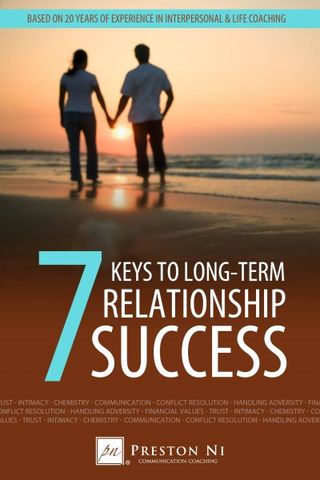Attachment
What is Your Relationship Attachment Style?
Understanding the four adult relationship attachment styles
Posted July 5, 2015 Reviewed by Kaja Perina

What is your interpersonal attachment style, and how might it affect your relationship? Based on the works of Bartholomew and Horowitz, etc., there are four adult attachment styles: Secure, Anxious-Preoccupied, Dismissive-Avoidant, and Fearful-Avoidant. Most people have various degrees of the four attachment styles, which may change over time.
Below are some of the most dominant traits of each type in relationships, with references from my book “7 Keys to Long-Term Relationship Success”.
Secure Attachment Style
Those with a strong Secure Attachment Style manifest at least a number of the following traits on a regular basis:
- Higher emotional intelligence. Capable of conveying emotions appropriately and constructively.
- Capable of sending, and receiving healthy expressions of intimacy.
- Capable of drawing healthy, appropriate and reasonable boundaries when required.
- Feel secure being alone as well as with a companion.
- Tend to have a positive view of relationships and personal interactions.
- More likely to handle interpersonal difficulties in stride. Discuss issues to solve problems, rather than to attack a person.
- Resiliency in the face relational dissolution. Capable of grieving, learning, and moving on.
People with the Secure Attachment Style are not perfect. They too have ups and downs like everyone else, and can become upset if provoked. Having said this, their overall mature approach to relationships makes this the healthiest of the four adult attachment styles.
Anxious-Preoccupied Attachment Style
Those with a strong Anxious-Preoccupied Attachment Style tend to manifest at least several of the following traits on a regular basis:
- Inclined to feel more nervous and less secure about relationships in general, and romantic relationships in particular.
- Inclined to have many stressors in relationships based on both real and imagined happenings. These stressors can manifest themselves through a variety of possible issues such as neediness, possessiveness, jealousy, control, mood swings, oversensitivity, obsessiveness, etc.
- Reluctant to give people the benefit of the doubt, tendency for automatic negative thinking when interpreting others’ intentions, words, and actions.
- Requires constant stroking of love and validation to feel secure and accepted. Responds negatively when not provided with regular positive reinforcement.
- Drama oriented. Constantly working on (sometimes inventing) relationship issues in order to seek validation, reassurance, and acceptance. Some feel more comfortable with stormy relationships than calm and peaceful ones.
- Dislike being without company. Struggle being by oneself.
- History of emotionally turbulent relationships.
Dismissive-Avoidant Attachment Style
Those with a strong Dismissive-Avoidant Attachment Style tend to manifest at least several of the following traits on a regular basis:
- Highly self-directed and self-sufficient. Independent behaviorally and emotionally.
- Avoid true intimacy which makes one vulnerable, and may subject the Dismissive-Avoidant to emotional obligations.
- Desire freedom physically and emotionally (“No one puts a collar on me.” Pushes away those who get too close (“I need room to breathe.”)
- Other priorities in life often supersede a romantic relationship, such as work, social life, personal projects and passions, travel, fun, etc. In these situations, the partner is frequently excluded, or holds only a marginal presence.
- Many have commitment issues. Some prefer to be single than to settle down. Even in committed relationships, they prize autonomy above much else.
- May have many acquaintances, but few truly close relationships.
- Some may be passive-aggressive and/or narcissistic. For more on these traits see my books "How to Successfully Handle Passive-Aggressive People" and "How to Successfully Handle Narcissists".
Fearful-Avoidant Attachment Style
Those with a strong Fearful-Avoidant Attachment Style tend to manifest at least several of the following traits on a regular basis:
- Often associated with highly challenging life experiences such as grief, abandonment and abuse.
- Desire but simultaneously resist intimacy. Much inner conflict.
- Struggle with having confidence in and relying on others.
- Fear annihilation, physically and/or emotionally in loving, intimate situations.
- Similar to the Anxious-Preoccupied Style, suspicious of others’ intentions, words, and actions.
- Similar to the Dismissive-Avoidant Style, pushes people away and have few genuinely close relationships.
As mentioned earlier, most people have various degrees of the four attachment styles, which may change over time.
Although those who are predominantly the Secure Attachment Style tend to make strong partners, it is also possible for those who are predominantly the other three styles to be in successful relationships. Self-awareness, mutual-support, mutual willingness to grow, and courage to seek professional help when needed are some of the crucial elements to positive relational development. The absence of these elements, however, may generate issues of incompatibility in relationship.

For more tips on relationship success, see my books (click on titles): “7 Keys to Long-Term Relationship Success”, and "How to Communicate Effectively and Handle Difficult People”.
© 2015 by Preston C. Ni. All rights reserved worldwide. Copyright violation may subject the violator to legal prosecution.
Select References
(1) Bartholomew, K., Horowitz, L.M. Attachment Styles Among Young Adults: a Test of a Four-Category Model. J Pers Soc Psychol. (1991)
(2) Pietromonaco P.R., Barrett L.F. Working Models of Attachment and Daily Social Interactions. J Pers Soc Psychol. (1997)


